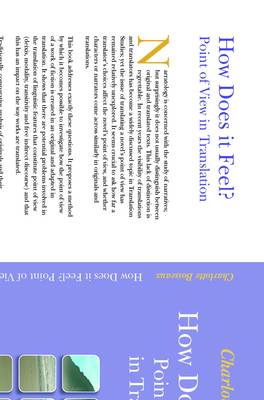
- Afhalen na 1 uur in een winkel met voorraad
- Gratis thuislevering in België vanaf € 30
- Ruim aanbod met 7 miljoen producten
- Afhalen na 1 uur in een winkel met voorraad
- Gratis thuislevering in België vanaf € 30
- Ruim aanbod met 7 miljoen producten
Zoeken
How Does It Feel? Point of View in Translation
The Case of Virginia Woolf Into French
Charlotte Bosseaux
€ 131,45
+ 262 punten
Omschrijving
Narratology is concerned with the study of narratives; but surprisingly it does not usually distinguish between original and translated texts. This lack of distinction is regrettable. In recent years the visibility of translations and translators has become a widely discussed topic in Translation Studies; yet the issue of translating a novel's point of view has remained relatively unexplored. It seems crucial to ask how far a translator's choices affect the novel's point of view, and whether characters or narrators come across similarly in originals and translations.
This book addresses exactly these questions. It proposes a method by which it becomes possible to investigate how the point of view of a work of fiction is created in an original and adapted in translation. It shows that there are potential problems involved in the translation of linguistic features that constitute point of view (deixis, modality, transitivity and free indirect discourse) and that this has an impact on the way works are translated.
Traditionally, comparative analysis of originals and their translations have relied on manual examinations; this book demonstrates that corpus-based tools can greatly facilitate and sharpen the process of comparison. The method is demonstrated using Virginia Woolf's To The Lighthouse (1927) and The Waves (1931), and their French translations.
This book addresses exactly these questions. It proposes a method by which it becomes possible to investigate how the point of view of a work of fiction is created in an original and adapted in translation. It shows that there are potential problems involved in the translation of linguistic features that constitute point of view (deixis, modality, transitivity and free indirect discourse) and that this has an impact on the way works are translated.
Traditionally, comparative analysis of originals and their translations have relied on manual examinations; this book demonstrates that corpus-based tools can greatly facilitate and sharpen the process of comparison. The method is demonstrated using Virginia Woolf's To The Lighthouse (1927) and The Waves (1931), and their French translations.
Specificaties
Betrokkenen
- Auteur(s):
- Uitgeverij:
Inhoud
- Aantal bladzijden:
- 252
- Taal:
- Engels
- Reeks:
- Reeksnummer:
- nr. 29
Eigenschappen
- Productcode (EAN):
- 9789042022027
- Verschijningsdatum:
- 1/01/2007
- Uitvoering:
- Paperback
- Formaat:
- Trade paperback (VS)
- Afmetingen:
- 155 mm x 235 mm
- Gewicht:
- 430 g

Alleen bij Standaard Boekhandel
+ 262 punten op je klantenkaart van Standaard Boekhandel
Beoordelingen
We publiceren alleen reviews die voldoen aan de voorwaarden voor reviews. Bekijk onze voorwaarden voor reviews.








